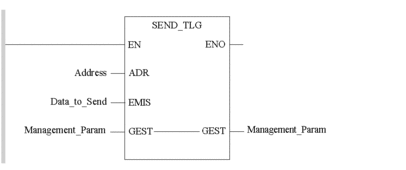Function Description
The SEND_TLG function is used to send telegram-type
data to a remote application.
The data to be sent must be a maximum of 16 bytes in length. Unlike the other communication functions, this function is processed immediately (synchronous): there are therefore no activity bit and timeout parameters.
The integer table assigned to the management parameters therefore only uses two words instead of four (the exchange and timeout numbers being unnecessary).
| WARNING | |
|---|---|
The additional parameters EN and ENO can be configured.
FBD Representation
Representation:

LD Representation
Representation:

IL Representation
Representation:
LD AddressSEND_TLG Data_to_Send, Management_ParamST Representation
Representation:
SEND_TLG(Address, Data_to_Send, Management_Param);Description of the Parameters
The following table describes the input parameters:
Parameter |
Type |
Comment |
|---|---|---|
|
|
Address of the destination entity of the exchange. Only the {Network.Station}APP or {Network.Station}APP.num addresses are authorized. |
|
|
Integer table to be sent to the destination device of the request. This must be a maximum of 8 integers (16 bytes) in length. Note: it is essential that the number of bytes to be sent is placed in the second word of the management table before executing the exchange. |
The following table describes the input/output parameters:
Parameter |
Type |
Comment |
|---|---|---|
|
ARRAY [0 ... 1] OF |
Table of words used to manage the exchange. This table is made up of 2 words: the report word and the length word for the data to be sent. The report comprises:
The operation report takes one of the following values:
|


